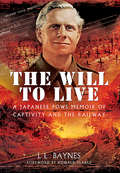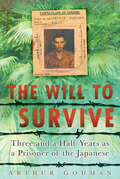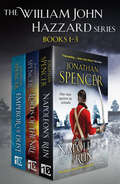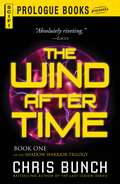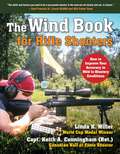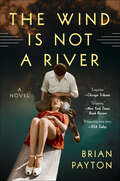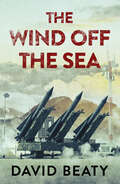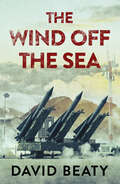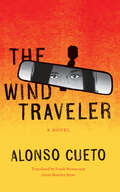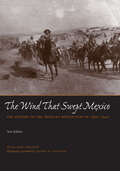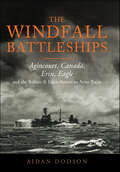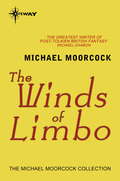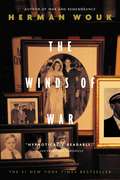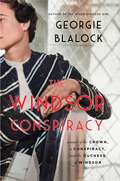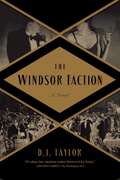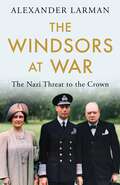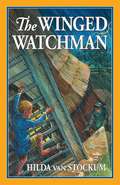- Table View
- List View
The Will to Live: A Japanese POWs Memoir of Captivity and the Railway
by L.L. BaynesThe Author kept a diary recording his 1,000 days of captivity at the hands of the Japanese army. The difficulties and risks involved in this task were immense, yet he persevered although it meant deliberately defacing and cutting up the small pieces of paper. As a result, his memoir is both contemporaneous and entirely reliable.Reading this account of life and death during the fruitless fighting and his subsequent captivity in numerous camps in Singapore and on the Death Railway in Thailand is a humbling and moving experience. He describes not just the appalling hardship and brutality but, tellingly, his relationships with fellow POWs, his captors and the local population. As an NCO, Len found himself fronting up for his men and, being a self-sufficient man with strong beliefs, this led to some difficult situations, at times, with both the Japanese and his British superiors. While critical about a number of the latter, he has nothing but respect for others such as the legendary Colonel Toosey of Tamarkan Camp.Thanks to his honest and direct style, The Will To Live is a fine and inspiring firsthand example of the ever popular Japanese POW/Railway of Death genre. It reveals much about the nightmare experiences suffered by the Author and his colleagues and the way they coped under the most adverse conditions. His drawings complement the text and the Foreword by Ronald Searle, also a POW, speaks for itself.
The Will to Survive: Three and a Half Years as a Prisoner of the Japanese
by Arthur GodmanTaken prisoner after the fall of Singapore in 1942, Arthur Godman spent the next three and a half years on the Burma-Siam railway, living in camps along the River Kwai. Like other PoWs, he experienced disease and malnutrition and witnessed the painful deaths of many of his comrades. Yet somehow he retained his sense of humour and perspective, recalling, among the casual cruelties inflicted by the Japanese, small acts of kindness between guards and prisoners which enabled him to retain his faith in humanity. In order to survive he attempted to achieve a relationship with his captors based on their common experience of adversity, learning Thai, teaching bridge and stealing food. The Will to Survive gives the reader a glimpse of the terrifying world of the PoW and includes pictures by another famous captive, Ronald Searle.
The William John Hazzard series
by Jonathan SpencerJourney from drizzly, 18th century Britain to sun-baked Egypt with The William John Hazzard series. Includes all three books; Napoleon’s Run, Lords of the Nile, and the 2022 Wilbur Smith Adventure Writing Prize-longlisted Emperor of Dust.Napoleon's Run: London, 1798. Late one night, a junior naval officer at the Admiralty intercepts a coded despatch, marked with blood: Napoleon Bonaparte is about to launch the largest invasion fleet in history. England is vulnerable, bereft of allies, and the Sea Lords fear a direct assault on Britain. Admiralty Intelligence sounds the alarm and prepares to unleash Nelson and the Mediterranean squadron. But before they can, they need vital information. They need a special officer to uncover the destination of Napoleon’s armada – they need Marine Lt William John Hazzard. Betrayed by the Admiralty at the African Cape three years earlier, Hazzard has vowed never to trust them again. Will he agree to help them?Lords of the Nile: Malta, June 1798. Captured by the French after hurling himself into enemy ranks, Hazzard is now a prisoner of his arch-nemesis, spycatcher Citizen Derrien, but has uncovered the true purpose of Napoleon’s armada: the conquest of Egypt. If Hazzard can’t convince Admiralty Intelligence of a desperate plan, an ancient world will be lost for ever. But help comes from an unexpected quarter: a missing Admiralty agent… As French cannons roar in the desert sands and the Mamluk cavalry sweeps in to attack, can Hazzard prevent a lost cause turning into tragedy?Emperor of Dust: Egypt, September 1798. After tragedy at the Battle of the Nile, Hazzard is possessed by a dark vengeance: with the marines of 9 Company and their Bedouin allies he scours the Nile Delta for his nemesis, the French spy-catcher Citizen Derrien. However, among the sacred ibis and ever-shifting sands, Hazzard catches wind of the stirrings of revolt in Cairo. When riot explodes in the capital, Hazzard fears he is simply too late. Abandoned by the French Government, Napoleon and his army are now trapped in Egypt. When Bonaparte discovers that Al-Djezzar ‘the Butcher’ of Acre is gathering his forces to attack, he accepts the challenge. Riding with the Mamluk and the beautiful Shajar al-Durr, Hazzard engages French cavalry in the shadow of Ozymandias in ancient Thebes – and the Admiralty calls upon him once more as Napoleon launches his bloody crusade on Syria and the Holy Land to become the new Emperor in the East.These epic adventures with a new hero of Napoleonic fiction are perfect for fans of Bernard Cornwell, Simon Scarrow and C. S. Forester.Praise for Jonathan Spencer‘An outstanding novel… Better than Sharpe, gripping and intense, Napoleon’s Run deserves to be a runaway success.’ Ben Kane, Sunday Times bestselling author of Lionheart‘Hornblower meets Mission: Impossible. A thrilling, page-turning debut packed with rousing, rip-roaring action.’ J. D. Davies, author of the Matthew Quinton Journals'Outstanding... Packed to the gunwales with action, this fast-paced story introduces us to William Hazzard … not only a convincing action hero, but also one who offers a timeless insight into loyalty, trust and honesty. A thumping read' Chris Lloyd, author of The Unwanted Dead‘Eloquently crafted and dripping with richly detailed historical and fictional characters… a riveting tale of heartbreak, anguish, courage and love. Spencer is a master storyteller, captivating and entertaining.’ Quarterdeck on Emperor of Dust
The Wilson Plot
by David LeighIn a historic decision, the House of Lords on October 12 reversed the Thatcher government's ban on "quoting from Spycatcher" opening the way for the publication in England and the United States of The Wilson Plot -the highly controversial and explosive account of what the spycatchers were really up to. Using hitherto unknown material from Peter Wright, author of Spycatcher, and interviews with dozens of his sources, the London Observer's David Leigh has put together an unbelievable story of paranoia and treachery in the British and American intelligence agencies, revealing a wealth of "dirty tricks" played against democratic governments - a treason never discussed in the other spycatcher books. Leigh traces the spycatchers' obsession that Labour prime minister Harold Wilson was, incredibly, a Soviet spy - and shows how they tried to persuade British officers to join in an attempt to overthrow the popularly elected government. Leigh discusses the role of CIA chief James Angleton and uncovers the true motives of Wilson's accusers: playing on anti-communist hysteria, the CIA and MI5 set out to defame those individuals whose politics interfered with the intelligence agenda. Amazingly, such plots succeeded in Australia, and perhaps even toppled Willy Brandt's government in Germany as well. In exploring the incredible complexities of postwar espionage, Leigh turns a bright light on the murky corners of a secret world that is illuminated here for the first time.
The Wind After Time
by Chris BunchTen years has passed since the Great War - and mankind was victorious against the Al'ar, their loathsome alien foes.But Joshua Wolfe, hero of the war, knows it's not over. He knows the Al'ar and their ways. He knows what their plans are.And he knows they'll be back.Long ago, the Al'ar gave him a name: Shadow Warrior. The time has come to fulfill its lethal promise.
The Wind After Time: Book One of the Shadow Warrior Trilogy
by Chris BunchTen years has passed since the Great War - and mankind was victorious against the Al'ar, their loathsome alien foes. But Joshua Wolfe, hero of the war, knows it's not over. He knows the Al'ar and their ways. He knows what their plans are. And he knows they'll be back. Long ago, the Al'ar gave him a name: Shadow Warrior. The time has come to fulfill its lethal promise.
The Wind After Time: Book One of the Shadow Warrior Trilogy
by Chris BunchTen years has passed since the Great War - and mankind was victorious against the Al’ar, their loathsome alien foes.But Joshua Wolfe, hero of the war, knows it’s not over. He knows the Al’ar and their ways. He knows what their plans are.And he knows they’ll be back.Long ago, the Al’ar gave him a name: Shadow Warrior. The time has come to fulfill its lethal promise.
The Wind Book for Rifle Shooters: How to Improve Your Accuracy in Mild to Blustery Conditions
by Linda K. Miller Keith A. CunninghamAll other factors being equal, it is your ability to read the wind that will make the most difference in your shooting accuracy. The better you understand the behavior of the wind, the better you will understand the behavior of your bullet. Now, champion shooters Linda K. Miller and Keith A. Cunningham reveal everything they wish they&’d known about reading the wind before they started shooting (instead of having to learn as they went along) in concise, easy-to-read terms and accompanied with handy ninety-five diagrams. The Wind Book for Rifle Shooters contains straightforward guidance on the simple thought process they use to read the wind, the techniques and tactics they use to win matches, and the underlying skills that support both. Let these champions show you how to put together a simple wind-reading toolbox for calculating wind speed, direction, deflection, and drift. Then learn how to use these tools to read flags and mirage, record and interpret your observations, and time your shots to compensate for wind. Other topics covered include: Analyzing shot placementRecording and record keepingConfidence and following your hunchesAnd much more!The essential wind-reading basics taught in this book will absolutely improve your shooting skills, whether you're a target shooter, a plinker, a hunter or a shooting professional.
The Wind Is Not a River: A Novel
by Brian PaytonBrian Payton’s The Wind Is Not a River is a gripping tale of survival and an epic love story set during the only World War II battle on American soil.Following the death of his younger brother in Europe, journalist John Easley is determined to find meaning in his loss. Leaving behind his beloved wife, Helen, he heads north to investigate the Japanese invasion of Alaska’s Aleutian Islands, a story censored by the U.S. government. While John is accompanying a crew on a bombing run, his plane is shot down over the island of Attu. He survives only to find himself exposed to a harsh and unforgiving wilderness, known as “the birthplace of winds.” There, John must battle the elements, starvation, and his own remorse while evading discovery by the Japanese. Alone at home, Helen struggles with the burden of her husband’s disappearance. Caught in extraordinary circumstances, in this new world of the missing, she is forced to reimagine who she is—and what she is capable of doing. Somehow, she must find John and bring him home, a quest that takes her into the farthest reaches of the war, beyond the safety of everything she knows. “A haunting love story wrapped in an engaging and unsettling history lesson . . . Along the way, readers will learn not just about a fascinating and largely forgotten slice of American history, but what it felt like to live through it.” —USA Today“Payton crafts a beautiful, heart-inspiring and heart-wrenching tale of love, forgiveness, loneliness, the strength of the human spirit, and the power of faith in God and family.” —Pittsburgh Post-Gazette
The Wind Off the Sea
by David BeatyOne man&’s disappearance could signal the beginning of WWIII in this military mystery thriller from an acclaimed author and former Royal Air Force pilot. After a spectacular career as an airman, Group Captain Gavin Gallagher became the Commanding Officer of the most powerful nuclear rocket station in the world. Then he vanished without a trace. One day, he left the Zeus launching pads to return home to his wife . . . and never arrived. From the Provost Marshal&’s office, Wing Commander Henderson is tasked with investigating the mystery before it erupts into a national emergency. Has Gallagher been kidnapped, or has he &‘gone over&’? Could he have been murdered? And what clues can be found in his past: his rise from wing undergraduate to war hero, to one of the few top men who literally hold the key to human survival?
The Wind Off the Sea
by David BeatyOne man’s disappearance could signal the beginning of World War Three.Group Captain Gavin Gallagher, after a spectacular career as an airman, was the Commanding Officer of the most powerful nuclear rocket station in the world. Until he vanishes, without a trace.He left the Zeus launching pads to return home to his wife – and never arrived. From the Provost Marshal's office, Wing Commander Henderson is tasked with investigating the mystery that might well become a national emergency.Has Gallagher been kidnapped, or has he ‘gone over’? Could he have been murdered? And what clues can be found in his past: his rise from wing undergraduate to war hero, to one of the few top men who hold, literally, the key to human survival?A gripping, deeply moving tale of World War Two and the Cold War, perfect for fans of Alan Furst and John le Carré.
The Wind Traveler: A Novel (Latin American Literature in Translation)
by Alonso Cueto&“Staggering . . . [A] compulsively readable story of a man&’s reckoning with a history of violence [and] an essential work of Peruvian literature.&” ―Publishers Weekly, starred review A seemingly ordinary man named Ángel sells kitchenware at a store in Lima. In the early 1990s, he had served as a soldier, engaging in brutal acts whose aftermath still reverberates. Now he is forced to reckon with his past when a woman he was instructed to kill enters the store and buys a few items. How can she still be alive? What&’s more, how can she not recognize Ángel? Remarkably, she asks him to deliver her purchases to her house. From this moment, Ángel feels compelled to make amends through any means necessary, even if it requires sacrificing his life of quiet retirement. A stirring tribute to the wounded souls who yearn to make peace with the past, The Wind Traveler offers a new vision of the fragile human connections that sustain a deeply fractured world. &“A lyrical novel about loss and atonement . . . Cueto&’s scenes and descriptions are tactile and immediate, conveying subtext and deeper meaning.&” ―Foreword Reviews
The Wind that Swept Mexico: The History of the Mexican Revolution of 1910-1942 (Texas Pan American Series)
by Anita Brenner&“100 pages of text and 184 historical news photographs . . . This is the Mexican Revolution in its drama, its complexity, its incompleteness.&” —Bertram D. WolfeThe Mexican Revolution began in 1910 with the overthrow of dictator Porfirio Díaz. The Wind That Swept Mexico, originally published in 1943, was the first book to present a broad account of that revolution in its several different phases. In concise but moving words and in memorable photographs, this classic sweeps the reader along from the false peace and plenty of the Díaz era through the doomed administration of Madero, the chaotic years of Villa and Zapata, Carranza and Obregón, to the peaceful social revolution of Cárdenas and Mexico&’s entry into World War II.The photographs were assembled from many sources by George R. Leighton with the assistance of Anita Brenner and others. Many of the prints were cleaned and rephotographed by the distinguished photographer Walker Evans.&“Here is the history of the revolution in 184 of the best photographs of the time. The whole disintegration and painful reintegration of a society is marvelously set before the eyes.&” —Times Literary Supplement&“A classic and sympathetic statement of the first of the great twentieth century revolutions—its words and pictures command our attention and our respect.&” —Military History&“One could not have seen it more closely and fully had one taken part in it.&” —Bertram D. Wolfe
The Windfall Battleships: Agincourt, Canada, Erin, Eagle and the Latin-American & Balkan Arms Races
by Aidan DodsonThis new book explores for the first time the full story of how two Turkish and two Chilean battleships became British capital ships after the outbreak of the First World War. Under construction by the shipbuilding giants of Armstrong and Vickers in August 1914, Sultan Osman I, Reșadiye, Almirante Latorre and Almirante Cochrane became HM Ships Agincourt, Erin, Canada and Eagle. The first three served with the Grand Fleet, fighting at Jutland, while the last was transformed into a pioneering aircraft carrier, which would serve with distinction until sunk while escorting a convoy to Malta in 1942. While two of the other ships had short lives – cut short by the Washington Naval Treaty – the final ship, Almirante Latorre, would be returned to Chile after the war, for a continuing active career that would last into the 1950s. When finally towed away for scrap in 1959, she was the penultimate survivor of Jutland. Drawing on extensive archival research, the book begins with an overview of the warships under construction around Europe for foreign customers in August 1914, and how the four ships featured were acquired by the Royal Navy. It then looks at them as manifestations of the international rivalries which directed much of the national budgets of impecunious South American and Balkan states towards armaments. The focus then switches to the British service of the ships actually completed as battleships, and then to the story of the carrier. Although never finished as a battleship, she would play a crucial role in the development of British carrier aviation. Finally, the author traces the stories of the battleships of the Latin-American naval race from the 1920s down to the 1950s. The stories and back-stories of Agincourt, Erin, Canada and Eagle embrace almost the whole of the twentieth-century battleship era, and they take us down the byways of international naval power, ranging from the Pacific to the Black Sea, and from the line of battle to mutiny and revolution. A fascinating and original story.
The Windflower (The beloved, classic tale of passion on the high seas)
by Laura LondonThe classic tale of passion on the high seas, available in print for the first time in 20 years and in ebook for the first time ever... Laura London's beloved novel will be adored by fans of Julie Garwood, Jude Deveraux, Loretta Chase, Johanna Lindsey and Kathleen E. Woodiwiss.Merry Wilding is a lady of breeding, of innocence, and of breathtaking beauty. With high hopes for a holiday in England, she sets sail from New York-but the tide of her life is destined to turn. Mistakenly swept aboard an infamous pirate ship, Merry finds herself at the mercy of a wicked crew...and one sinfully handsome pirate. Soon she's spending her days yearning for escape, and her nights learning the pleasures of captivity.Devon Crandall believes Merry is in league with his greatest enemy. He's determined to slowly urge her secrets from her. But along the way, he discovers her beautifully unbreakable spirit...and a desire unlike any he's ever known. She is hiding something from him, and yet, each day that passes brings her deeper into his heart. When fierce arguments give way to fiercer passion, can a pirate learn to love a woman? Or will true love be lost at sea?Fall in love with the richly romantic, classic love stories of Laura London, as her beloved novels are released in ebook for the first time.
The Winds Of War & War And Remembrance Boxed Set
by Herman WoukThese two classic works capture the tide of world events even as they unfold the compelling tale of a single American family drawn into the very center of the war's maelstrom. The multimillion-copy bestsellers capture all the drama, romance, heroism, and tragedy of the Second World War and constitute Wouk's crowning achievement.
The Winds of Limbo
by Michael MoorcockHe was a mysterious cosmic presence who came out of nowhere with the incredible promise to free the dying planet. Earth's future is one of peace. There are no more wars, nuclear weapons are outlawed, and technology is raising mankind to new heights. Many cities are now underground. Alain von Bek is a bastard of distinguished lineage working an unassuming job with city administration in the underground city of Switzerland. But with the appearance of a massive clownish figure calling himself the Fireclown, Alain's life and the course of Earth's future are both about to change. The Fireclown claims to hold the keys to mankind's salvation. He carries an undeniable charisma that is winning him followers, chief among them Helen Curtis, Alain's cousin and former lover, not to mention serious candidate in the next presidential election. But there are also those who mistrust the Fireclown. At the forefront of this opposition is Minister Simon von Bek, Alain's grandfather, and Helen's chief competition in the forthcoming election. Gradually, Alain finds himself sucked into a game of chess between these three polarizing forces, but each new revelation raises new questions, about his past and that of the world's future. He will have to put his trust in someone, and time is running out-for him and the world.
The Winds of War
by Herman WoukFollows the various members of the Henry family as they become involved in the events preceeding America's involvement in World War II.
The Windsor Conspiracy: A Novel of the Crown, a Conspiracy and the Duchess of Windsor
by Georgie BlalockGeorgie Blalock, the acclaimed author of The Other Windsor Girl, delivers an enchantingly reimagined fictional portrait of Wallis Simpson through the lens of her cousin who is engaged to spy on the Duchess of Windsor for her alleged Nazi sympathies and finds much more than she bargained for!American Amelia Montague defied her family five years ago to marry the man she loved, but that decision cost her everything. Disowned by her family, and left a penniless widow after her husband’s death, Amelia becomes her cousin Wallis Simpson’s private secretary in France. With no other prospects available, Amelia has no choice but to succeed, and under their Aunt Bessie’s direction, hopes to have a positive influence on Wallis and the Duke of Windsor.During the next two years, Amelia realizes that not everything with the Windsors is glittering happiness. Beneath the façade of the besotted couple simmers Wallis’s rage at her stunted ambition, and the couple soon reveal themselves to be self-centered Nazi supporters who pursue their own interests at any cost.When the Germans invade France, and the Windsors leave Amelia to escape the Gestapo on her own, Amelia finds herself in position to work for the most unlikely of employers: MI5 and the FBI. Convinced to work undercover, Amelia joins the Windsors in Nassau and soon realizes that Wallis’s treachery extends far deeper than the US and British government even knows…Richly imaginative, Georgie Blalock’s novel stuns as it explores two women, opposites in every way, and the choices they make to survive both war and each other. . .
The Windsor Faction
by D.J. TaylorIf Wallis Simpson had not died on the operating table in December 1936, Edward VIII would not have been King of England three years later. He would have abdicated for &“the woman he loves,&” but now, the throne beckons. If Henry Bannister&’s car had not careened off the Colombo back-road in the summer before the war, Cynthia Kirkpatrick would never have found out about The Faction. It is autumn 1939, and everything in history is just as it was. Except, that is, for the identity of the man in Buckingham Palace and the existence of a secret organization operating at the highest levels of society and determined to derail the war effort against Nazi Germany. From the staff of the newly-founded literary magazine, Duration, hunkered down in their Bloomsbury square, and the country house parties full of renegade Tory MPs, to Tyler Kent, the Embassy cipher clerk with his sheaf of stolen presidential telegrams, the journalist Beverley Nichols deviously at work on an alternative King&’s Speech, while a Lancashire lad named Rodney nervously runs errands from his Maida Vale antiques shop to the House of Commons. The Windsor Faction is an ingenious exercise in might-have-been, which assembles a cast of real and imaginary people in a horrifyingly plausible re-invention of history.
The Windsors at War: The Nazi Threat to the Crown
by Alexander LarmanAt the outbreak of WW2, the British monarchy was in a state of turmoil. The previous king, Edward VIII, had abdicated the throne, leaving his unprepared and terrified brother Bertie to become George VI. Meanwhile, as the now-Duke of Windsor awaited the decree that would allow him to marry his mistress Wallis Simpson, he took an increasing interest in the expansionist plans of the Führer of Germany. The Windsors at War tells the story of the turbulent and seismic decade in between 1937 and 1947, including the bombing of Buckingham Palace in May 1940, the Duke of Windsor's ill-advised visit to Germany in October 1937 and the death of the Duke of Kent in a plane crash in August 1942. It answers a simple question: how did this squabbling, dysfunctional family manage to put their differences aside and unite to help win the greatest conflict of their lifetimes?
The Winemaker's Wife
by Kristin HarmelThe author of the &“engrossing&” (People) international bestseller The Room on Rue Amélie returns with a moving story set amid the champagne vineyards of France during the darkest days of World War II, perfect for fans of Heather Morris&’s The Tattooist of Auschwitz.Champagne, 1940: Inès has just married Michel, the owner of storied champagne house Maison Chauveau, when the Germans invade. As the danger mounts, Michel turns his back on his marriage to begin hiding munitions for the Résistance. Inès fears they&’ll be exposed, but for Céline, the French-Jewish wife of Chauveau&’s chef de cave, the risk is even greater—rumors abound of Jews being shipped east to an unspeakable fate. When Céline recklessly follows her heart in one desperate bid for happiness, and Inès makes a dangerous mistake with a Nazi collaborator, they risk the lives of those they love—and the vineyard that ties them together. New York, 2019: Recently divorced, Liv Kent is at rock bottom when her feisty, eccentric French grandmother shows up unannounced, insisting on a trip to France. But the older woman has an ulterior motive—and a tragic, decades-old story to share. When past and present finally collide, Liv finds herself on a road to salvation that leads right to the caves of the Maison Chauveau.
The Winemaker's Wife: An internationally bestselling story of love, courage and forgiveness
by Kristin HarmelIf you love The Tattooist of Auschwitz and The Beekeeper's Promise and then you'll adore this beautiful story of love, hope and survival. East of Paris in the sun-drenched vineyards of northern France lies the glamorous champagne house Maison Chauveau. But as the Nazis march closer and the Resistance builds strength, it becomes clear the grand house is not all it seems. 1940: When young Ines married into the famed Chauveau family she dreamt of peace and luxury. But with German occupation comes a life of fear: for herself, for family and friends joining the Resistance and for Celine, the Jewish wife of their chief vintner. As tensions mount and loyalties are tested, Ines will be faced with a terrible choice. 2019: Liv Kent has lost everything: her job, her husband and the family she thought they were building. Alone and adrift she leaps at the chance to join her eccentric grandmother on a trip to Champagne. But it's not long before past and present collide, and in a desperate search for the truth, Liv is led straight to the Maison Chauveau.If you loved The Winemaker's Wife then check out Kristin Harmel's instant bestseller The Book of Lost Names, out now.What readers are saying about The Book of Lost Names:'A heart-stopping tale of survival and heroism centered on a female forger who risks everything to help Jewish children escape Nazi-occupied France' People Magazine, '20 Best Books to Read this Summer''Brilliantly imagined' Publishers Weekly, Starred Review'Heartbreakingly real with a dash of suspense and romance' Booklist___________What readers are saying about The Winemaker's Wife: 'A beautifully woven tale of love, betrayal and redemption' Goodreads reviewer, 5 stars 'This is a story of love through generations, of the French Resistance and families of blood and choice. Fabulous read!' Amazon reviewer, 5 stars 'A memorable book that weaves a heartbreaking, yet hopeful, tale. This book is fascinating and a must read!' Goodreads reviewer, 5 stars 'It is a story of love and betrayal. It's also a story of forgiveness ... kept me intensely interested until the very end' Amazon reviewer, 5 stars 'A deeply thoughtful historical fiction novel, based on details of real-life Resistance activities that occurred in France during World War II' Gwendalynbooks.blog 'I would highly recommend The Winemaker's Wife to those who like historical fiction and women's fiction. A 5 star for me!' Stories Unfolded Blog 'This was a wonderfully twisty book ... I definitely want to read more from this author' The Good, the Bad and the Unread
The Winged Tiara
by J'nell CiesielskiDiamonds and danger dazzle in Ciesielski's latest enchanting romp through post-war Europe as estranged spouses and jewel thieves hunt an elusive Valkyrie tiara.November 12, 1918. It was a match made in champagne-soaked heaven, but all too soon the bubbles dried up, and Esme Fox awakens the morning after celebrating the end of the Great War to find herself shockingly and accidentally married. She gathers her belongings and slips out before her new husband can stop her. After all, she knows it's best to leave before he does.Four years later, Jasper Truitt, after having made a name for himself in the underground world of jewel thieves, is on the hunt for a valuable heirloom: a one-of-a-kind winged tiara--the last Valkyrie tiara ever created. So it's with great surprise that he discovers it at a charity event atop the head of a woman he's never forgotten. His long-lost wife . . . who happens to be pursuing the tiara for a vengeful opera diva desperate to obtain the jewel for herself.The reunion is cut short when Esme vanishes--again--but their separation is temporary. With a hitman on their heels and a deadline looming, the pair find themselves in an epic game of cat and mouse across Europe following leads from the French Riviera to a shop of wonders in Venice, a fairy-tale castle in Bavaria, and a veritable circus thrown by a champagne heiress, all before a dramatic horseback flight through the French countryside.In the end only one can win, and with both of their hearts on the line, the winner may well turn out to be the loser.In her latest glamorous historical romance, J'nell Ciesielski spins a sparkling story filled with her signature snappy dialogue and vivid atmosphere that will keep you reading late into the night to see what happens next.
The Winged Watchman (Young America Book Club)
by Hilda Van StockumThis acclaimed story of World War II is rich in suspense, characterization, plot and spiritual truth. Every element of occupied Holland is united in a story of courage and hope: a hidden Jewish child, an "underdiver," a downed RAF pilot, an imaginative, daring underground hero, and the small things of family life which surprisingly carry on in the midst of oppression. The Verhagen family, who live in the old windmill called the Winged Watchman, are a memorable set of individuals whose lives powerfully demonstrate the resilience of those who suffer but do not lose faith.
